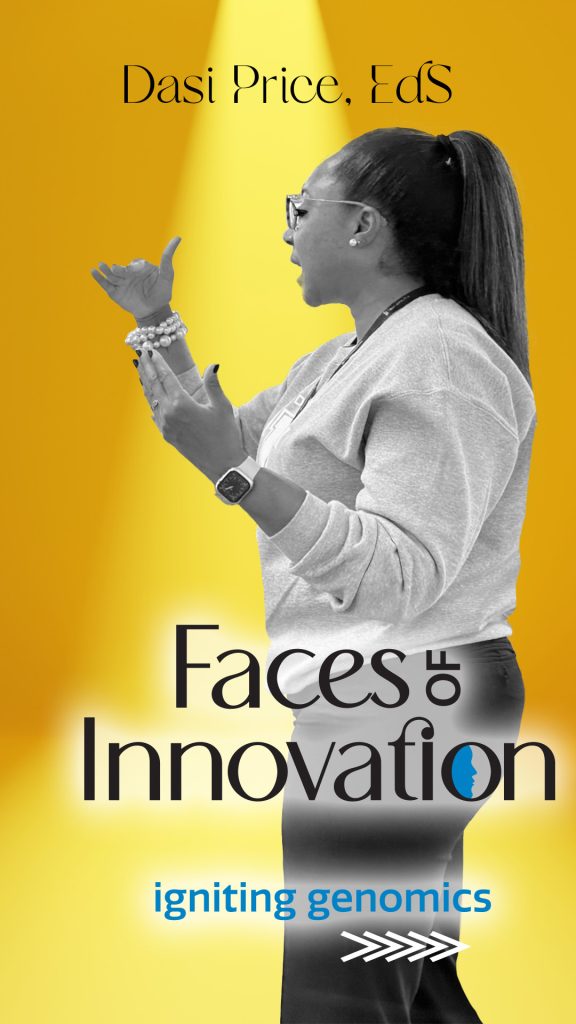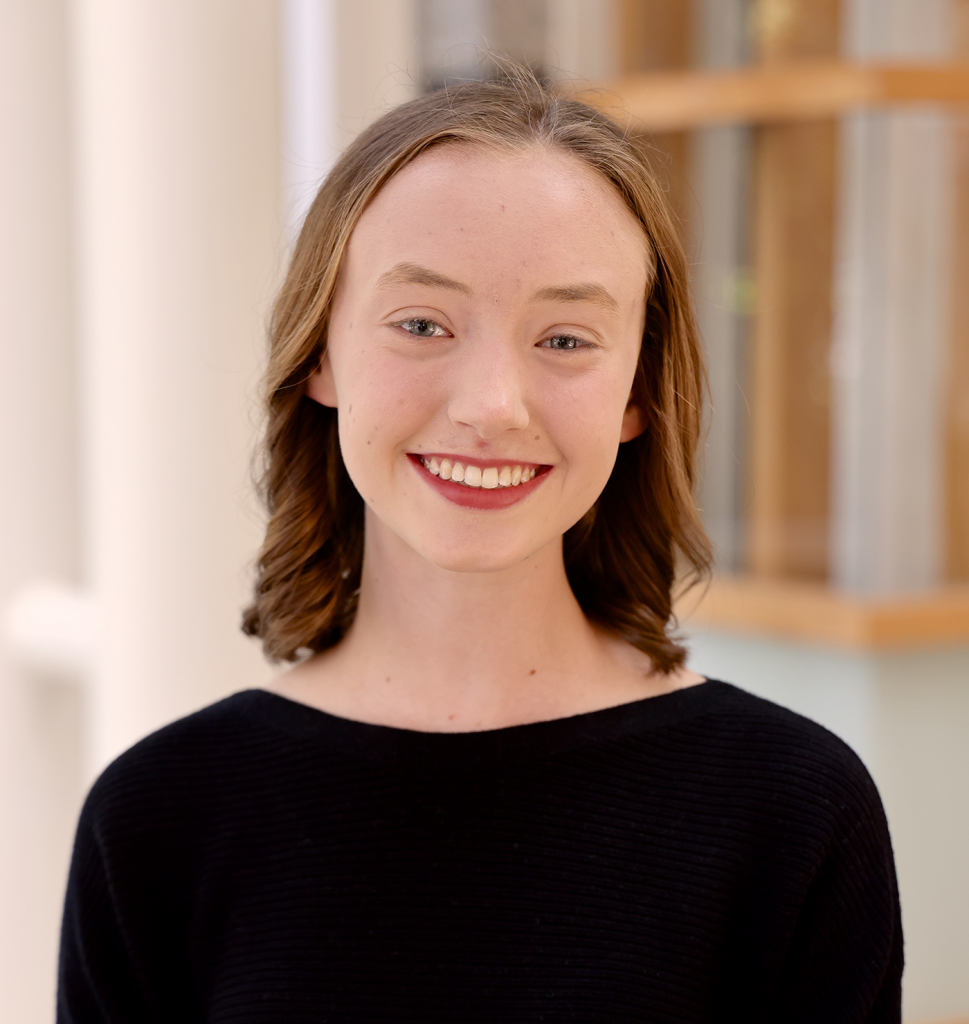The HudsonAlpha Institute for Biotechnology campus is home to hundreds of scientists using genomics to improve our lives on a daily basis. But before those scientists became the brilliant visionaries they are today, they had to experience a spark of joy that led them down the STEM education path. Many of them probably had a teacher, mentor, or memorable experience that led them to the sciences.
At HudsonAlpha, a team of educators is sparking STEM joy and curiosity in students across the country from elementary school through college. Today’s Face of Innovation is Dasi Price, Ed.S., the Director of Student Experiences at HudsonAlpha.
Sarah Sharman: You’re the Director of Student Experiences here at HudsonAlpha. What exactly does that mean?
Dasi Price: I wear a lot of different hats, but the sum total of my job is that I get the opportunity to create experiences for K-12 students that help them better understand genomics and biotech. These experiences could be anything from a physical hands-on activity to a classroom kit or module that is shipped to a teacher to a Saturday STEM event where students come in and use the same types of equipment that our researchers are using.
Sarah: Tell me a little bit about yourself. Were you always interested in a career in teaching and genetics?
Dasi: I have a Bachelor’s degree in biology from the University of Montevallo and an education certificate. Their program was set up so that you did a full biology course load and a full education course load. This was really helpful for me because I have a strong biology background to draw from when teaching others.
I did not set out to be a teacher, although I do have a robust history of teachers on both sides of my family. My mom was a teacher, so as a child, I saw the private side of teaching, the anxiety and frustration that my mom sometimes brought home. Upon losing my original scholarship at Montevallo, I was given the chance to receive a teaching scholarship that required me to teach for two years post-graduation. After graduation, I accepted a job at Birmingham City Schools, believing I would work through my two years and figure out what to do next. The problem with that plan: I felt a calling to pour into these students and share my love of the sciences with them.
Thirteen years and a few graduate degrees later, I was at my second HudsonAlpha teacher training event when I learned they were hiring for a position in the Educational Outreach department. I applied and was offered the job in 2013.

Sarah: Are there any projects or programs you’ve led at HudsonAlpha that really stand out to you?
Dasi: To date, the project that I am most proud of is the afterschool program called LABS (Launching Aspiring Biotechnology Sciences Program) that I developed and launched in 2014. The program came about from my desire to have a longer impact on students. One of the things that I miss about traditional classroom settings is that a student comes into your classroom in August, and by the time they leave, whether it is in May when they leave your class or they graduate as a senior, you get to see them change and grow.
When I started at HudsonAlpha, we were really good at fostering relationships with adults, like teachers and college students. For students, we only had shorter interactions. We would have small sparks of excitement with these students, but there weren’t many opportunities for them to continue interacting with us. At the same time, we realized a gap in lab exposure existed for under-resourced and underserved student populations.
I pitched the idea for LABS to Dr. Lamb (VP of Educational Outreach at HudsonAlpha at the time), and he found funds to pilot the program. We ran the pilot for six weeks and had really great feedback, so I asked for funding for another cohort of students. It went so well that we took a year off to develop a formal plan and go after more sustainable funding sources. We’ve been offering LABS every semester since 2017. Each cohort gains lab experience and knowledge for two consecutive semesters, culminating in a week-long summer experience. They leave the program with meaningful lab skills, confidence, and a feeling of belonging in STEM.
A really impactful part of the LABS program is that once students finish the program, they have close to 100 content hours from being in a research lab. Imagine graduating high school and being able to put that on your resume.
Sarah: One of your newer programs focuses on elementary-aged children. Why is it important to you to introduce students to STEM that early in their education?
Dasi: Much of our work is tied to the Alabama state course of study, and we’re really comfortable with that because it gives us the baseline to make sure that we’re helping to move education and be transformational in those formal spaces. In 2015, the Alabama course of study brought genetics to third grade, and it was our first chance to really ground ourselves and think about how we could help teachers at that level have resources.
We put together a formal classroom kit that went into third-grade classrooms. This was a major undertaking for me because I had to adjust to the third-grade teaching approach which is vastly different than my experiences with high schoolers. I worked with teachers to understand what concepts were appropriate, what reading level would work, and what activities would excite and engage the students.
From that formal kit we put together, we realized that there was a gap in informal learning opportunities. There are places like the Boys and Girls Club, the YMCA, the Huntsville Learning Center, and Girls Inc., that are doing amazing out-of-school programs with students. They want STEM-based activities and may not always have the expertise depending on staff, access to resources, and things of that nature. They have a need that we can fill with our expertise. So, I’ve been working on a program called Genetic Explorers that aims to put STEM-based learning opportunities in informal, educational after-school settings and summer programs so that students are exposed to genetic content and careers. One of the coolest parts of developing the program for me is that we didn’t have to stay so close to the state curriculum. So, we were able to do a few more curiosity-driven activities to really peak their enthusiasm and feed their inquisitiveness. This allows us to be impactful and sustainable with an elementary audience.
Sarah: Do you have any long-term goals for the STEM education field?
Dasi: If I could create the perfect world in STEM education, I would love that by the time every student finishes sixth grade, they have used a micropipette. And they’re comfortable using a micropipette. Part of what I’m doing with Genetic Explorers is introducing the students to the equipment and tools and teaching them how to use them so that when someone asks, ‘Have you used the micropipette?’ they can confidently say they have. When I taught in Birmingham City Schools, I took every last one of my ninth graders to the McWane Science Center, and they used micropipettes and other lab equipment. That was the first time I got excited about kids using science equipment. There is something so satisfying about using a micropipette for yourself and transferring a little bit of liquid from a tube to a 96-well plate. Now, instead of the 9th grade, I want every student in Alabama to experience using a micropipette by the time they hit 6th grade.

